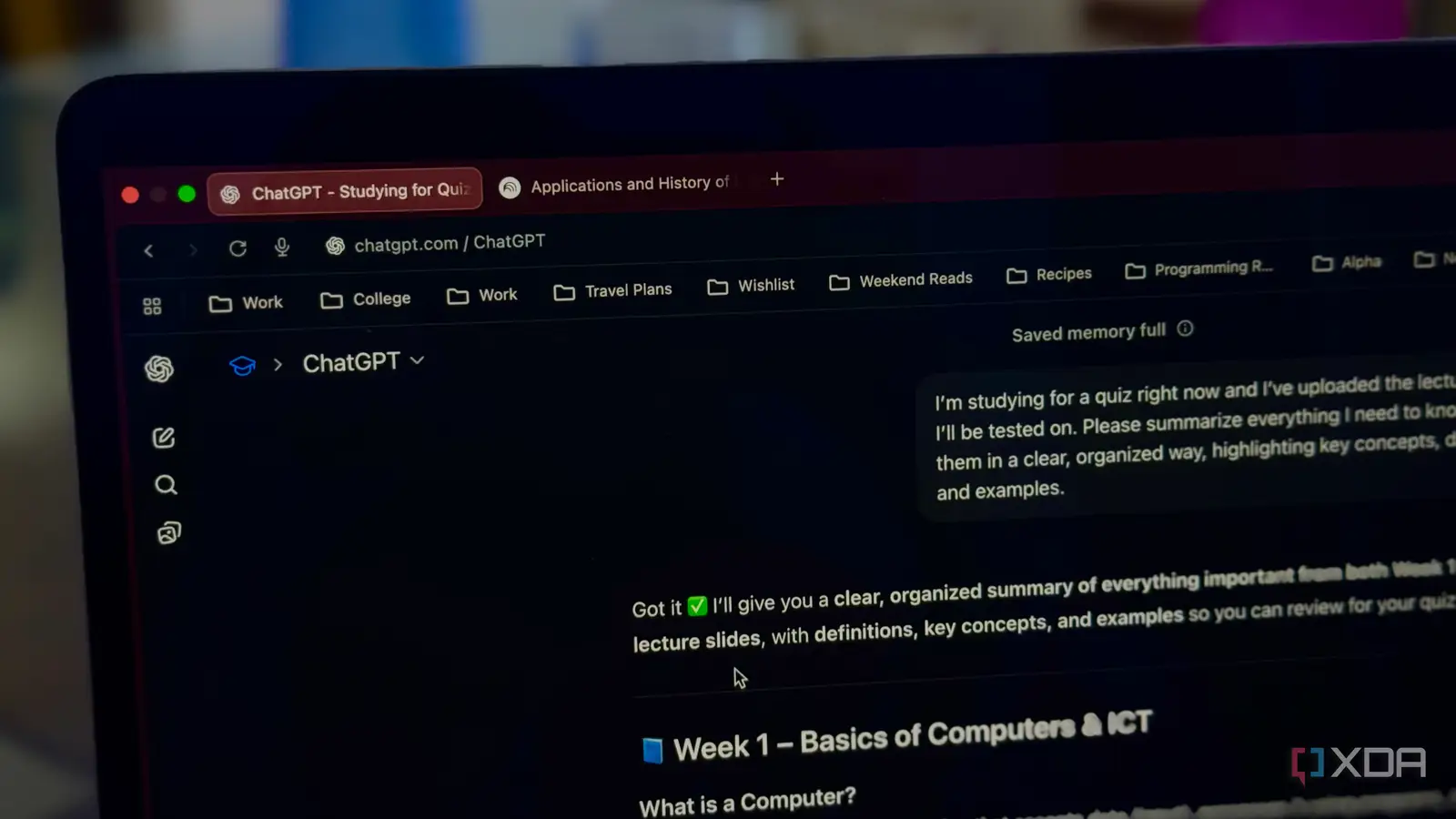
The first AI tool that comes to mind for most people when they hear “AI” is OpenAI’s ChatGPT. And the reason for that is simply because it was one of the first generative AI models to go mainstream. Even today, it’s still one of the go-to AI tools for most people. I test a lot of AI tools, both for work and my personal life, and one AI tool I use daily is Google’s NotebookLM.
Given that I’m a student and spend around half my day learning new information, NotebookLM is the tool that best fits my workflow. As much as I love the tool, if I come across a tool that claims to do the same thing better, I’m always willing to give it a shot. If it fits my workflow better than NotebookLM, I don’t mind making the switch.
Recently, I’ve heard talk of ChatGPT’s Projects feature, which seems to do something very similar to NotebookLM. So, just like I did with Adobe PDF Spaces, I decided to put ChatGPT’s Projects to the test.
What are Projects in ChatGPT
A better way to manage projects without losing context
ChatGPT Projects isn’t a new feature and has been around since December 2024. In an OpenAI Support article, the AI giant describes the feature as “smart workspaces” that allow you to keep everything related to a particular topic, project, or workflow in one place.
This means you can store documents, notes, and conversations together instead of juggling them across multiple chats. It’s actually a great concept that most AI tools should adopt at this point if they haven’t already. Instead of beginning a new chat thread every time you want to discuss or update something, Projects let you pick up right where you left off.
You can keep everything consolidated in a single place and build on past conversations without needing to re-explain what you’re trying to achieve. For example, say you need to analyze certain Excel sheets every week.
Instead of creating a new thread each week, you can simply drop the latest file into your Project, and ChatGPT will already have the context from your earlier conversations. This way, the AI tool can also reference the previous files, spot patterns across different weeks, and give you insights that build on past analyses.
ChatGPT’s Projects also have built-in memory, meaning the AI keeps track of all the chats and files you’ve uploaded and remembers them. Here’s where it gets similar to NotebookLM: you can add context to Projects to guide ChatGPT’s responses.
You can upload PDFs, spreadsheets, docs, or even images to give the AI material to reference in its answers. This is similar to NotebookLM’s source-grounded nature, where the AI only references material you’ve uploaded to answer your queries.
To create a new Project in ChatGPT, all you need to do is head to ChatGPT and hit the New project button in the sidebar. Then, name it and pick an icon and color. That’s how easy it is! You can also move an existing conversation thread into your project by dragging the chat into it. Alternatively, click the horizontal three dots (…) next to the chat you’d like to move and hit Move to project. Projects in ChatGPT are available to all free and paid subscribers.
So, how do ChatGPT Projects compare to NotebookLM?
The real showdown
The real question here is how ChatGPT Projects really stacks up against NotebookLM — which is exactly what I set out to test. When I first started playing around with ChatGPT Projects, I had a quiz I needed to study for. I typically use NotebookLM for this, so I decided to upload the same documents to both platforms just to see how each one handled them. Here’s the prompt I used:
I’m studying for a quiz right now and I’ve uploaded the lecture slides I’ll be tested on. Please summarize everything I need to know from them in a clear, organized way, highlighting key concepts, definitions, and examples.
ChatGPT managed to analyze the content I had uploaded and broke it down into bullets and key points to make the material easier to review. Different concepts were grouped into separate headings, and ChatGPT even added Sample Assignment/Exam-Style Questions. As expected, NotebookLM didn’t dissapoint here either. However, since I was comparing both platforms side-by-side, I did notice ChatGPT takes slightly longer to respond, and the answers were a tad bit less detailed than NotebookLM.
For the prompt above, NotebookLM also included comprehensive tables to make the material more digestible. This was especially useful for quickly comparing concepts at a glance. While ChatGPT’s breakdown was solid, NotebookLM’s added structure gave it a slight edge in this case. I then asked both ChatGPT and NotebookLM targeted questions from the content my lecture slides covered, like “Where is IT headed?” and I didn’t notice a difference in the quality of their answers. Both tools gave clear, relevant explanations that aligned well with the material.
ChatGPT isn’t exactly source-grounded like NotebookLM
Falls short on source-grounding
When I asked ChatGPT targeted questions based on my lecture slides or material I had uploaded to my Projects, it stayed grounded in the matieral I had uploaded. However, when I asked it soemthing outside my sources, like “What is XDA Developers,” it unfortunately did pull infromation from its own knowledge base instead. ChatGPT ended up giving me a breakdown of what XDA is, and funnily, it thought it was included in my quiz.
That’s where it really differs from NotebookLM, which only responds based on the files you upload. I tested this by asking NotebookLM the exact same question in the same notebook I was using to prep for a quiz. Its response was simple:
Based on the lecture slides provided, there is no mention of “XDA Developers.”
It then followed up with a quick recap of what my slides did cover. This source-grounded approach is exactly what makes tools like NotebookLM so valuable — you can trust that the answers will never drift beyond your own material. ChatGPT Projects, on the other hand, is powerful for brainstorming and filling gaps, but when you’re studying or working with sensitive data, having that strict boundary between your sources and outside knowledge can make a big difference.
Keep in mind that ChatGPT Projects can also access your previously stored Memory. When OpenAI says Memory works in Projects, it doesn’t just mean the content you’ve uploaded to that specific project. It can also pull in details you’ve shared with ChatGPT in the past, like your personal preferences, writing style, or even recurring context. This can be incredibly useful if you want consistency across different projects, but it also highlights why NotebookLM’s stricter source-grounding stands out. NotebookLM essentially builds a personalized AI for every single notebook, where it’s only familiar with the material you’ve chosen to add. That means each notebook stays siloed and context-specific. I began using ChatGPT thinking the Memory was specific to each project, but it unfortunately isn’t.
ChatGPT only nails one study feature NotebookLM offers
The rest… not so much
In my opinion, you can deal with the source-grounding differences depending on what you’re using each tool for. But where ChatGPT Projects really starts to feel limited is in its learning-focused features. NotebookLM offers a range of learning tools like the ability to convert your sources into podcast-style discussions called Audio Overviews (or even debates now).
You can also convert your notes into Flashcards or Quizzes, which has been a lifesaver when you’re cramming for an exam or trying to learn a new concept. NotebookLM also lets you organize content you upload into reports. When you’re dealing with a lot of sources (or a few rather long ones), you can also transform them into Mind Maps to quickly visualize how everything connects.
ChatGPT, on the other hand, only really offers one feature I’d consider a learning tool: its Study and learn mode. This mode is powered by “custom system instructions” written in collaboration with teachers, scientists, and pedagogy experts. Typically, when you ask ChatGPT (or any tool) a question, you’re often given the answer first. The focus is pretty much always on giving you the answer, rather than making sure you actually understand the process.
Study and learn mode flips that approach. Instead of just spitting out the answer, ChatGPT tries to guide you through the reasoning step by step in bite-sized, Socratic-like steps. The aim is to help you reach the answer yourself by showing you how to approach each problem.
NotebookLM recently introduced a Learning Guide conversational style, which apparently aims to do something similar. So, while I personally love ChatGPT’s Study and learn mode, it does lack the broader variety of structured learning tools that NotebookLM packs in.
ChatGPT’s free version is limited (and its sources are too)
Why would anyone want to pay for so little?
If you’ve read my articles before, you’re probably aware of just how much I use NotebookLM. Even with how heavily I rely on the tool, I’ve never felt the need to upgrade to its premium version. Its free tier is more than powerful enough to fit my study and research workflow. On NotebookLM’s free tier, you can add up to 50 sources in each of your notebooks.
ChatGPT Projects, on the other hand, limits you to only 5 files per project (on the free plan). Even ChatGPT’s highest-tier plans, like Pro, Business, and Enterprise, limit you to only 40 files per project. With NotebookLM’s premium tiers, the limit goes up to 300 files per notebook, which is a major difference.
The types of sources ChatGPT Projects accepts are also fairly limited. You can only add files and images, meaning multimedia or web-based sources like YouTube videos or webpages aren’t supported. As you may have guessed, NotebookLM accepts both YouTube videos and webpages.
So, would I ditch NotebookLM for ChatGPT?
Personally, I don’t think ChatGPT Projects is designed to fully replace NotebookLM. Sure, I’d use it to organize all my research that I conduct in ChatGPT and keep everything consolidated in one place, but it doesn’t yet match NotebookLM when it comes to study-focused tools or strict source-grounding.
The biggest drawback, in my opinion, is its source limits. When I can upload more files for free in NotebookLM than I can with ChatGPT’s highest-tier plans, why would I limit myself and switch to a tool that restricts my workflow?



